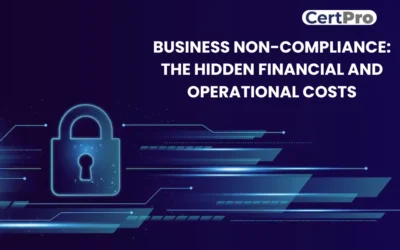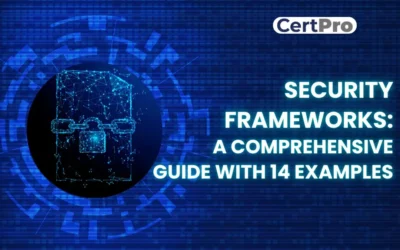ISO 45001:2018
OCCUPATIONAL HEALTH AND SAFETY MANAGEMENT SYSTEM
The ISO 45001:2018 certification is accepted worldwide. Therefore, it establishes standards for an OHSMS, or occupational health and safety management system. Its primary objective is to ensure a safe and healthy work environment. Thus, this certification demonstrates an organization’s commitment to safety. In addition, it aids in risk identification and management, lowers workplace mishaps, and promotes a culture that values safety. Further, ISO 45001 helps organizations set up organized procedures. Hence, it facilitates risk assessment and encourages the application of control measures. The standard aims to prioritize health and safety at work. This certification provides employee protection, which recognizes potential dangers and hazards. Again, it protects other interested parties and highlights a systematic approach to risk control. This method makes the workplace secure and safe for employees.
Furthermore, ISO 45001 stresses worker involvement, encourages consultation and participation and promotes a team-based strategy for safety management. Employing ISO 45001 gives enterprises authority, enhances their capacity to avert accidents at work, and aids in preventing diseases and deaths. This standard offers a thorough structure. The framework covers critical aspects. It includes hazard identification and risk assessment, emergency preparedness, and incident investigation. Therefore, adhering to this standard enhances safety performance and guarantees the workers’ health and welfare.
Moreover, ISO 45001:2018 certification has advantages. It provides a defined course for safety management. Companies can establish a secure atmosphere and promote a safety-conscious culture. Adherence to this criterion encourages health and safety. Accordingly, it guarantees that companies can safeguard their workers and protect other interested parties.

CERTIFICATION AND AUDITING SERVICES BY CERTPRO FOR ISO 45001:2018
We at CertPro are familiar with efficient health and safety administration. Accordingly, we recognize the importance of ISO 45001:2018 certification. We know that it is essential to enhance safety performance. Consequently, our professionals will assist you at every stage and offer comprehensive guidance throughout the certification process. Thus, we guarantee that your procedures comply with ISO guidelines.
Furthermore, we work with your team to develop and execute an effective OH&S system that meets your unique requirements. This technology also complies with industry requirements. At CertPro, we are committed to your success and work hard to ensure your company meets the strictest health and safety regulations.
Why choose CertPro for ISO 45001:2018 certification and auditing?
CertPro stands out as a reliable partner in ISO 45001:2018 certification. Additionally, we offer top auditing services. With nearly two decades of experience, we have refined our capabilities. Similarly, we have deep knowledge of health and safety management. Here are several reasons to choose CertPro. First, our expertise is unmatched. Second, our services are comprehensive with skilled professionals.
| Factors | CertPro Advantage |
|---|---|
| Time to Certification | 4x faster than traditional approaches |
| Price | Competitive rates with flexible options |
| Process | Streamlined and efficient methodology |
| Expertise | 10+ years of industry experience |
CertPro’s Cost-Effective Approach to ISO 45001:2018 Certification
The cost of ISO 45001:2018 certification can be intimidating. Multiple factors influence overall spending. We at CertPro are familiar with cost-effectiveness. Thus, we promise to provide superior solutions at affordable prices. These options are tailored to meet your requirements. This is a synopsis of our economic approach to ISO 45001:2018 certification:
| No. of employees | Timeline | Cost (approx.) |
| 1 – 25 | 4 weeks | 2500 USD |
| 25-100 | 6 weeks | 4500 USD |
| 100-250 | 8 weeks | 7500 USD |
| 250 plus | 8-12 weeks | Custom plans |
UNDERSTANDING ISO 45001:2018 AND ITS BASICS
ISO 45001 is a global standard that explicitly addresses work-related injuries and keeps people healthy and safe. The main goal is improving health and safety and making workplaces safer. Furthermore, ISO 45001 covers all organizations, including all sizes, industries, and locations. It also applies to internal and external factors that affect health and safety. In addition, the standard strongly emphasizes determining risks and hazards and concentrating on implementing controls that avoid incidents. Additionally, it encourages a secure workplace.
Likewise, ISO 45001 promotes a proactive strategy emphasizing employee involvement and ongoing improvement. Hence, leadership commitment is crucial. Consequently, organizations should establish clear objectives and implement effective processes. Besides, they must ensure compliance, including legal and regulatory requirements related to health and safety. By adopting ISO 45001, organizations enhance their safety culture. Moreover, the certification reduces accidents and injuries and improves employee well-being. Similarly, it shows commitment to a safe workplace. This is vital for the workforce and stakeholders.
Notably, the standard emphasizes risk assessment, which involves identifying and evaluating hazards. Therefore, it consists of implementing controls that mitigate or eliminate risks. Continuous improvement is fundamental. Organizations must monitor and assess OH&S performance and continually enhance it. Hence, ISO 45001 certification benefits any organization. It shows a commitment to safety, which includes all businesses. It is also crucial for high-risk activities and improves OH&S practices. In summary, ISO 45001 is essential and provides a clear framework, helps create a safe environment, and ensures employee well-being. Therefore, adopting ISO 45001 is wise for any organization.
KEY PRINCIPLES OF ISO 45001:2018 CERTIFICATION
The critical principle of ISO 45001:2018 certification focuses on promoting occupational health and safety (OH&S) within organizations. Therefore, the international standard provides a framework for establishing, implementing, maintaining, and continually improving an OH&S management system.
Leadership and Commitment: Top management exhibits leadership and dedication to OH&S since these qualities are essential in any firm. Thus, it defines goals and creates an efficient OH&S management system. Additionally, they assign the required resources.
Worker Involvement: Employers strongly emphasize worker involvement and offer opportunities. In addition, workers disclose risks, participate in decision-making, and actively participate in OH&S programs.
Risk-Based Approach: Employing a Risk-Based Approach encourages organizations to address OH&S issues proactively. Thus, it assesses and determines the risks before implementing control measures. These actions aim to lessen or remove worker health and safety risks.
Continual Improvement: Businesses routinely audit, assess, and monitor employee performance. Hence, pinpoint regions in need of development and implement remedial measures.
Legal compliance: Legal Compliance organizations must comply with legal and regulatory requirements. It must fulfill these obligations to protect workers’ health and safety.
Communication and Consultation: organizations establish precise communication mechanisms. Thus, the certification ensures timely communication on OH&S matters and consults workers on relevant issues.
Organizations that follow these guidelines can be certified ISO 45001:2018. This certification exhibits a dedication to offering a secure workplace and guaranteeing the well-being of its workforce.
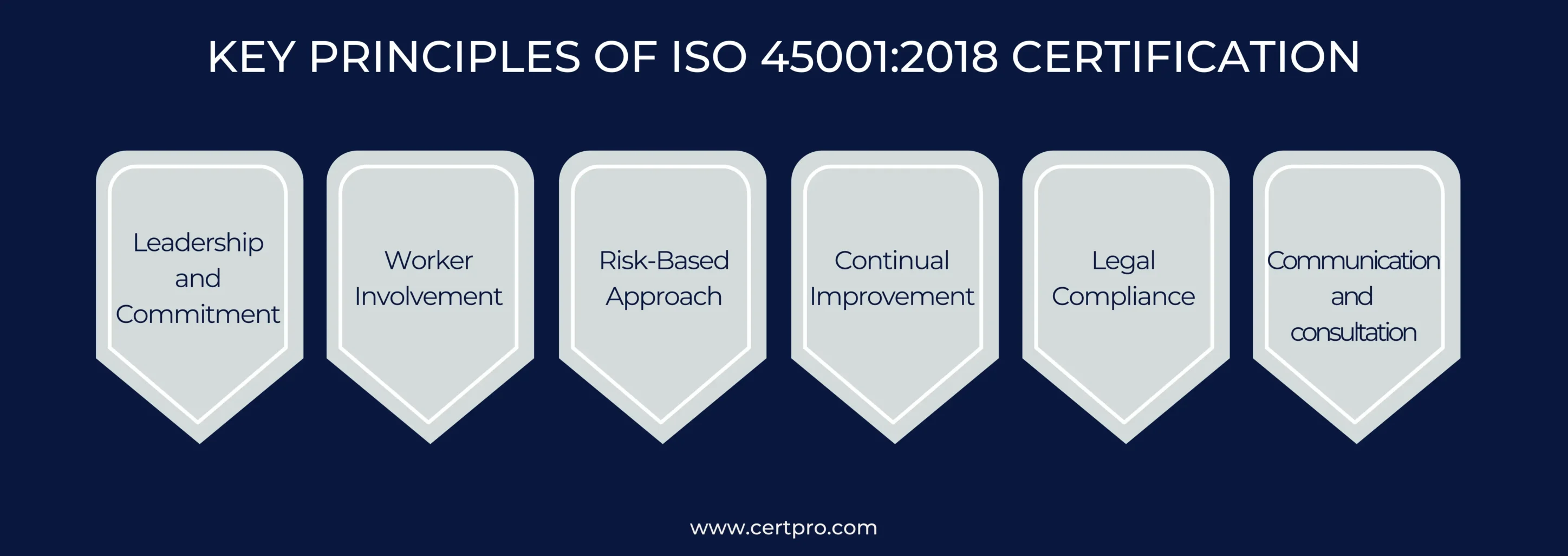
STEPS TO OBTAIN ISO 45001:2018 CERTIFICATION
Getting certified as an ISO 45001 requires a few steps.
Step 1: Understand ISO 45001:2018: First, get familiar with ISO 45001:2018 and determine its specs. Verify that you comprehend the fundamentals. Examine its elements. Investigate connections between ISO 14001 and ISO 9001 standards as well.
Step 2: Conduct Gap Analysis and Initial OH&S Review with Risk Analysis: Apply risk and gap analysis. Initially, conduct an OH&S evaluation and examine your present OH&S protocols. Thus, determine how your system differs from the ISO 45001 requirements. Do a comprehensive risk analysis, identify possible dangers, and acknowledge the potential threat.
Step 3: Develop a Comprehensive Plan: Create a detailed plan and outline necessary actions, resources, and timelines. Ensure it covers implementing ISO 45001 and addresses identified gaps. It should also include strategies for risk management.
Step 4: Educate and Raise Awareness: Teach staff members the value of OH&S and explain ISO 45001:2018. Therefore, an awareness-based culture should be encouraged, and active participation in safety precautions should be promoted.
Step 5: Design and Document Your OH&S Management System: Construct and record the OH&S management system. Incorporate the required steps and verify that they adhere to ISO 45001 standards. In this regard, you can utilize support resources and templates.
Step 6: Implement and Continuously Improve Your OHSMS: Put the system into practice and update it regularly. Ensure that employees follow the policies and collect evidence with care. Consequently, seek out ongoing methods to improve.
Step 7: Conduct Audits to Assess OH&S Performance: Use audits to evaluate OH&S performance. Thus, evaluate the OH&S management system’s effectiveness and verify that the ISO 45001 requirements are being followed. Assess what needs to be improved and prepare for the registrar’s audit of your registration.
Step 8: Attain Registration and Certification: Acquire certification and registration and conduct an audit of registration. Fix any non-conformances that the audit revealed. Obtain certification. Have the registrar carry out routine surveillance. Use certification to promote ISO 45001 compliance and dedication to occupational health and safety.
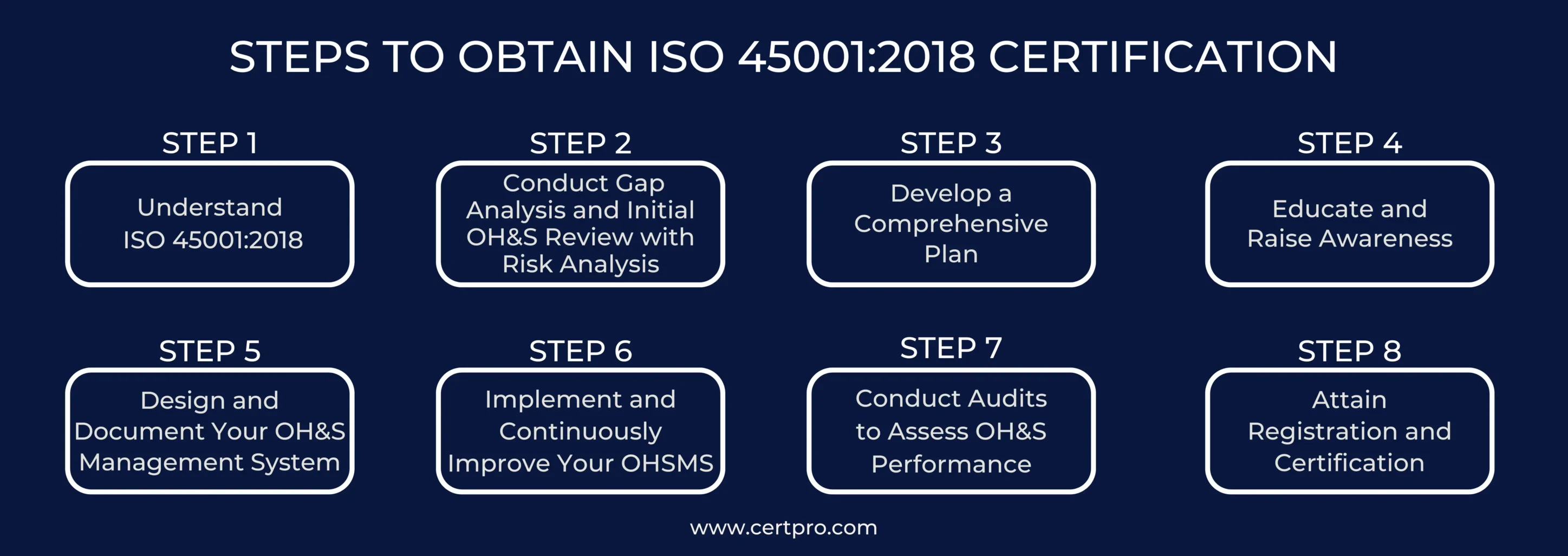
ISO 45001:2018 CERTIFICATION REQUIREMENTS
ISO 45001:2018 is divided into ten sections. References, definitions, and scope are covered in Sections 1-3. Following that, OH&S standards are outlined in Sections 4-10. It consists of planning, leadership, and organizational structure. These topics additionally cover performance evaluation, management, and assistance. Lastly, development is their primary concern.
Clause 4: Context of the Organization: It assesses relevance to OH&S within the company, evaluates chances and hazards associated with OH&S performance, defines scope, and establishes OH&S objectives.
Clause 5: Leadership and Worker Participation: Leadership and Worker Participation emphasize top management’s commitment. It stresses leadership and active worker involvement. This involvement is in establishing and maintaining the OH&S management system.
Clause 6: Planning: Planning requires organizations to set OH&S objectives and develop plans to achieve them. Thus, it also addresses opportunities and risks. Activities include hazard identification, risk assessment, risk treatment, legal considerations, and action planning to manage OH&S risks and accomplish goals.
Clause 7: Support: It includes competence and awareness. Moreover, it covers communication and documentation. This aids effective OH&S implementation.
Clause 8: Operation: Operation manages and controls processes, oversees changes and preparedness, and ensures contractor compliance. Suppliers must also meet OH&S standards.
Clause 9: Performance Evaluation: Performance Evaluation involves monitoring performance, measuring and analyzing data, conducting internal audits regularly, and conducting management reviews, essential for driving continual improvement.
Clause 10: Improvement: Improvement encourages corrective actions. It promotes learning from incidents. Additionally, it emphasizes preventive measures. Organizations strive for continual improvement. The OH&S system benefits from this focus.
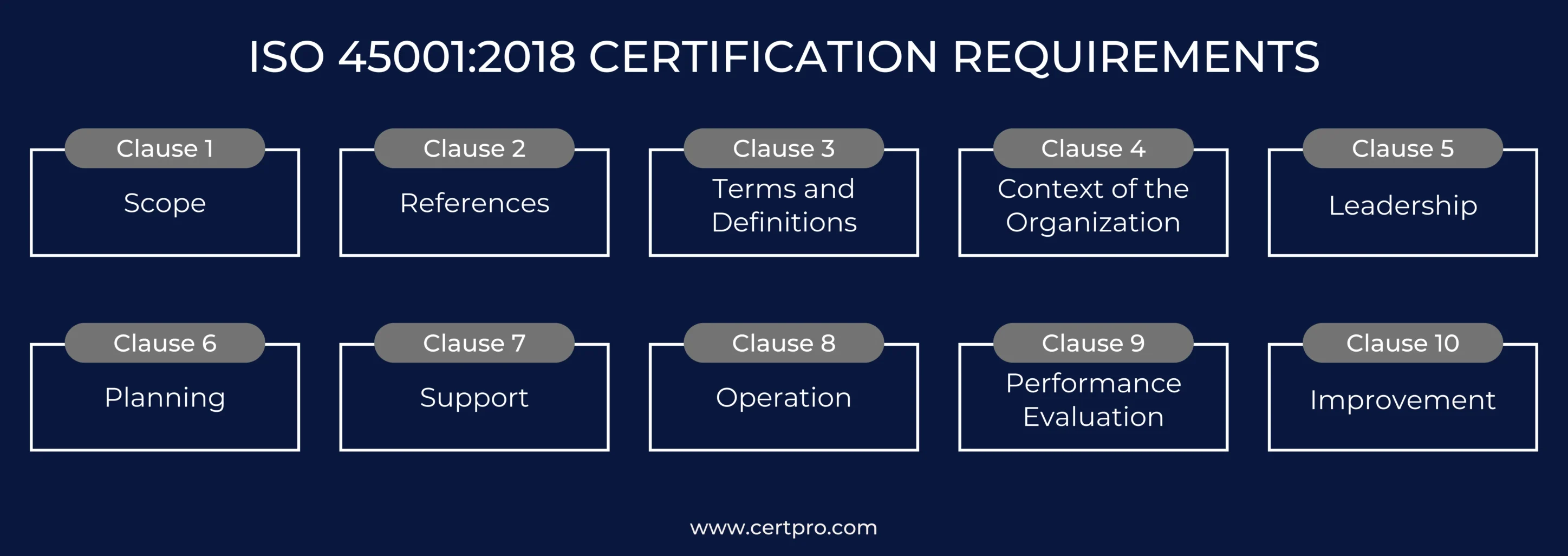
BENEFITS OF ISO 45001:2018 CERTIFICATION
- Improve Employee Safety: Improving employee safety is essential. ISO 45001:2018 enhances workplace measures and protects employees from hazards.
- Increase Productivity: A safe environment promotes productivity, reduces downtime from accidents, and lowers injuries.
- Lower Insurance Costs: Effective implementation reduces premiums. This occurs due to lower risk profiles.
- Reduce Risk: The standard emphasizes risk management. It enables hazard identification and effectively mitigates potential risks.
- Stand Out as an Industry Leader: It is essential to stand out as a leader. Thus, certification sets organizations apart and showcases a commitment to best practices, such as OH&S management.
- Shift from reactive to proactive: Shifting to proactive approaches is critical. Therefore, ISO 45001 encourages proactivity and helps address hazards early.
- Engage employees in safety: Engaging employees in safety is beneficial. Involving them fosters a safety culture, promotes active participation, and supports safety initiatives.
- Boost Stakeholder Confidence: Any business should increase its stakeholders’ trust. Certification shows a commitment to safety, instills stakeholder trust, and builds confidence.
- Foster Management Involvement and Accountability: ISO 45001 promotes active management, which drives a robust OH&S system and ensures accountability.
- Demonstrate your Commitment to Safety: It is essential to demonstrate commitment to safety. Thus, certification showcases high standards, reinforces an organization’s reputation, and proves dedication to safety.
ELIGIBILITY FOR ISO 45001:2018 CERTIFICATION
ISO 45001:2018 certification is available to all businesses and applies to any size or sector. It focuses on health and safety and helps establish an effective OH&S system. Thus, it ensures the well-being of employees and benefits stakeholders. Legal requirements do not limit eligibility; instead, it depends on commitment. By pursuing certification, businesses showcase their dedication. They provide a safe working environment, reduce occupational risks, and continuously improve OH&S performance. This certification is very relevant for organizations wanting better safety practices. It also meets customer expectations, satisfies stakeholder needs, and provides a competitive edge. ISO 45001 is a valuable tool that helps uphold safety standards. Furthermore, it shows commitment to well-being. Consequently, it benefits the entire organization.
THE COST OF ISO 45001:2018 CERTIFICATION
The ISO 45001 certification cost includes various factors. First, it involves implementing the management system, which requires purchasing the necessary standards. Additionally, training classes are essential to engage consultants and auditors. These expenses depend on the organization’s size and complexity. The initial ISO 45001 cost may seem high. However, a well-operating system saves money over time. Additionally, businesses prioritizing health and safety report fewer accidents. Moreover, injuries decrease as a result.
Furthermore, a proactive risk assessment protects your reputation and prevents legal issues. Therefore, obtaining ISO 45001 certification is an investment that makes every workplace safer. Lastly, it improves overall company functioning and opportunities.
ENSURING ISO 45001:2018 CERTIFICATION VALIDITY
The validity of ISO 45001:2018 certification hinges on several factors. Initially, certification lasts for three years. During this time, surveillance audits ensure ongoing compliance. Organizations must maintain and improve their management systems. After three years, organizations seek recertification. This process involves a comprehensive evaluation to determine whether they meet ISO 45001 requirements. Successful recertification confirms ongoing commitment and improvement. It’s crucial to note continuing compliance and improvement. Organizations must address non-conformities promptly and implement corrective actions effectively, ensuring the OH&S system remains effective.
CERTPRO: GUIDING YOUR BUSINESS TOWARD ISO 45001:2018 CERTIFICATION EXCELLENCE
CertPro specializes in helping businesses achieve ISO 45001 certification. We offer auditing, consulting, and certification services with experienced auditors and consultants. CertPro guides your business through certification and by following best practices. We assess your OH&S management system, identify areas for improvement, and help implement policies. Therefore, CertPro provides documentation support, training, and expert guidance for ISO 45001 compliance. Partnering with CertPro shows commitment to safety. It mitigates hazards and enhances workplace health. Hence, attaining ISO 45001 certification with CertPro enhances your reputation. It strengthens your market position.
FAQ’s
HOW MUCH TIME DOES IT TAKE TO GET ISO 45001:2018 CERTIFIED?
The timeframe for ISO 45001 certification depends on various factors, including the organization’s readiness and the complexity of its operations. It typically takes several months to a year or more to implement the necessary systems, conduct audits, and address any non-conformities identified during the process.
WHAT OCCURS FOLLOWING THE ATTAINMENT OF ISO 45001:2018 CERTIFICATION?
After achieving ISO 45001 certification, organizations must maintain and improve their occupational health and safety management systems. It involves conducting internal audits, addressing non-conformities, performing management reviews, and undergoing regular surveillance audits to ensure ongoing compliance with the standard.
CAN ISO 45001:2018 BE INTEGRATED WITH OTHER MANAGEMENT SYSTEMS?
Yes, ISO 45001 can be integrated with other management systems, such as ISO 9001 for quality management and ISO 14001 for environmental management. This integration allows organizations to streamline their processes, eliminate duplication, and achieve synergies in managing health and safety, quality, and environmental aspects effectively.
WHAT IS THE COST ASSOCIATED WITH ISO 45001:2018 CERTIFICATION?
The cost of ISO 45001 certification varies depending on factors such as the size and complexity of the organization, the scope of the certification, and the chosen certification body. It typically includes expenses for implementation, training, audits, and ongoing maintenance and can range from a few thousand dollars to tens of thousands of dollars.
CAN ISO 45001:2018 CERTIFICATION IMPROVE A COMPANY'S REPUTATION AND MARKET COMPETITION?
Yes, ISO 45001 certification can enhance an organization’s reputation and market competitiveness. It demonstrates the organization’s commitment to occupational health and safety, instills confidence among stakeholders, and differentiates the organization from competitors. It can also attract clients, partners, and customers who prioritize safety and responsible business practices.
NAVIGATING DATA PRIVACY FRAMEWORKS: A COMPREHENSIVE GUIDE
Globalization has intense effects on business functioning and scaling. In today's digital world, companies are generating an unprecedented rate of data that requires protection from emerging cyber threats. In addition, recurring data breaches and privacy concerns make...
BUSINESS NON-COMPLIANCE: THE HIDDEN FINANCIAL AND OPERATIONAL COSTS
Businesses are always in a dilemma regarding whether or not to be compliant. Most companies think that compliance will problematize their operating process. However, highly regulated industries like financial and healthcare services meet the legal obligations for...
Security Frameworks: A Comprehensive Guide with 14 Examples
Technological advancements make cyberattacks more sophisticated and advanced. Hence, organizations must keep up with the latest cybersecurity frameworks in these complicated scenarios to sustain themselves in a dynamic threat environment. Different cybersecurity...


